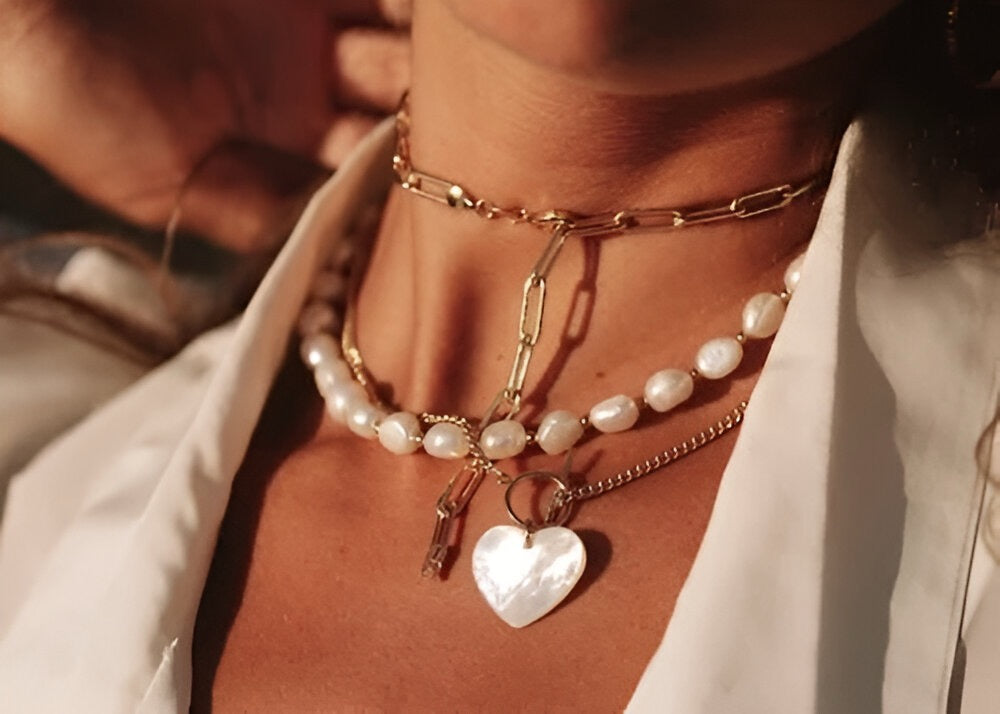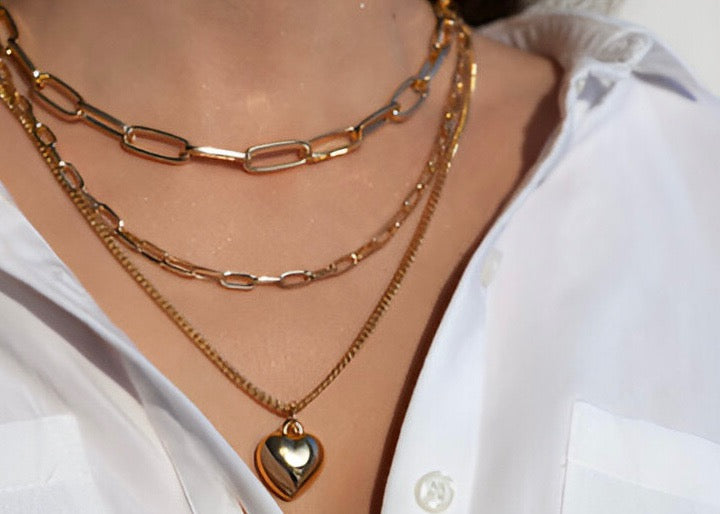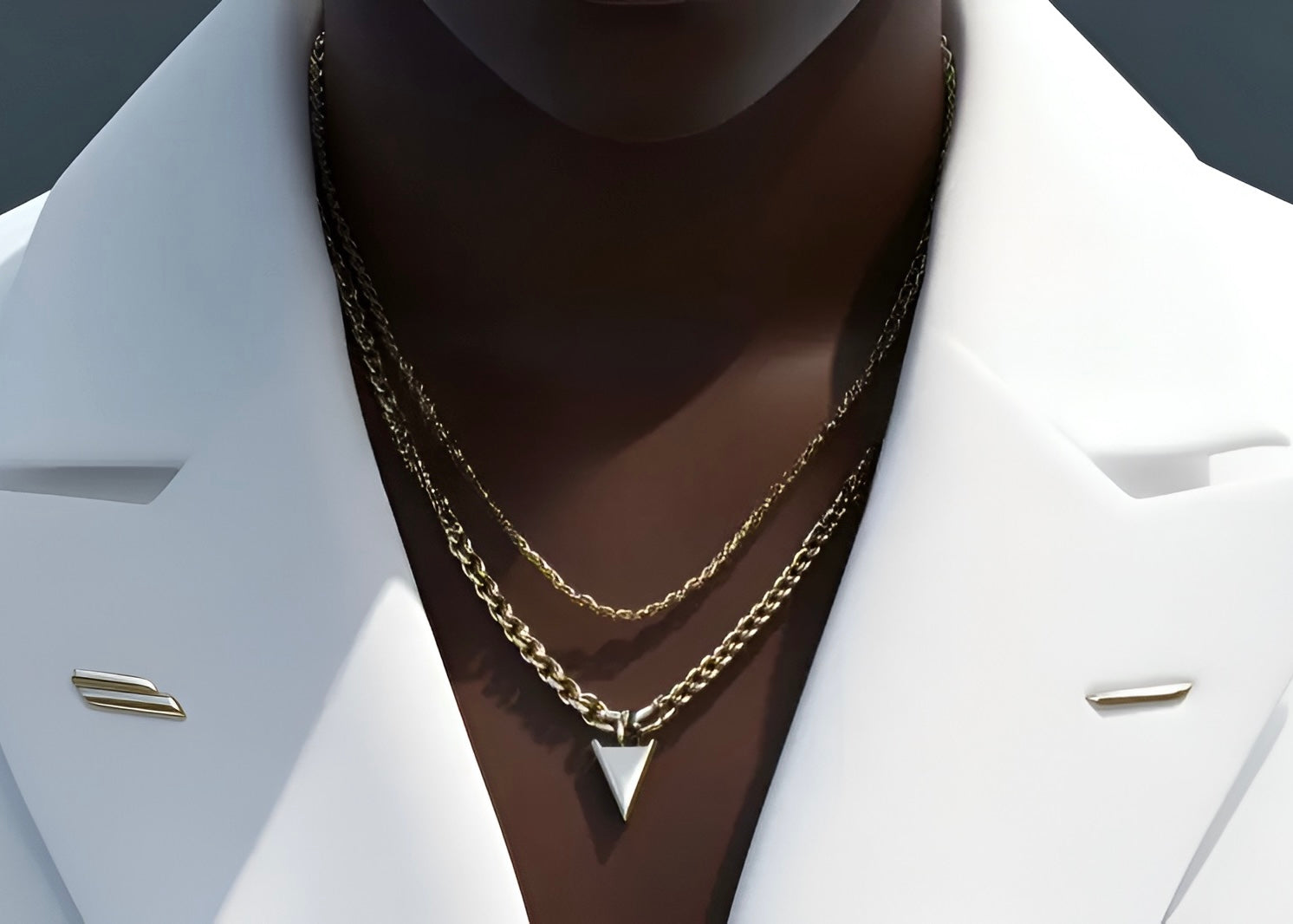
Chain layering guide: step by step to the perfect look
Your guide to the perfect layered necklace look
You see it everywhere: on Instagram, in magazines, on style-conscious women on the street - the artful layering of several necklaces, also known as chain layering. It looks so effortlessly chic, so individual and yet somehow harmonious. But if you try it yourself, it sometimes ends up in a knotted mess or just looks... weird? Don't worry, you're not alone! The art of combining several necklaces has a few little secrets, but they are easy to learn.
Chain layering is more than just a trend; it's a wonderful way to express your personal style, breathe new life into your favorite pieces and add that certain something to your outfit. Whether you prefer a minimalist look or something more opulent, with the right technique you can create unique combinations. This guide is your personal chain layering guide - packed with tips and tricks to make your layering look a success from now on.
We take a look at why this trend is so popular, the basic rules you should follow and how to put together your own perfect layering look step by step. Ready to take your jewelry styling to the next level?
The allure of layering: why we love necklace layering
What makes layering necklaces so special? It is not only a fashion statement, but also offers many advantages:
- Pure uniqueness: hardly any two layering looks are the same. You combine your personal favorite pieces and create a combination that only exists once - your very own jewelry signature.
- Styling flexibility: a simple sweater or T-shirt is instantly enhanced by cleverly layered necklaces. You can create the same look, sometimes understated, sometimes more eye-catching, just by the choice and arrangement of your chains.
- Old treasures rediscovered: Do you perhaps have a necklace that you no longer wear so often on its own? In a layering look, it can suddenly become a star again and shine in new splendor. It's a great way to revitalize your existing necklace collection.
- Dimension and interest: Several necklaces of different lengths and textures add depth to your décolleté and draw the eye. The result is an exciting interplay of light, shadow and movement.
- Tell stories: Perhaps you combine an heirloom with a new favorite piece or necklaces that remind you of special moments. Your layering look can also tell a very personal story.
In short: chain layering is creative, personal and simply fun!

The golden rules: How to make your necklace layering a success
There are a few basic principles that almost always work so that your layering attempt doesn't turn into a knotted mess. They are your compass on the way to the perfect look.
1. vary the lengths - the be-all and end-all!
This is the most important rule of all! If you wear necklaces of very similar lengths on top of each other, they will inevitably get tangled and look more like a lump. Instead, choose necklaces in clearly different lengths so that each chain has its own place and is clearly visible.
A good distance between the individual chains is often around 3-5 cm. A classic and often very harmonious combination consists of three chains, for example:
- A short necklace (choker or princess, approx. 40 cm)
- A medium-length chain (approx. 45-50 cm)
- A slightly longer chain (matinee, approx. 55-60 cm)
This difference in length ensures that the chains fall nicely staggered and do not constantly get in each other's way. Think of a small cascade!
2. play with textures and weights (but don't overdo it)
A layered look becomes even more interesting if you not only combine the same fine chains, but also play with different structures. Give it a try:
- A delicate anchor chain
- A slightly more present Figaro or curb chain
- Perhaps a fine snake chain or a chain with small balls (satellite chain)
The weight also plays a role. You can combine a very fine necklace with a slightly heavier one. The key is balance: if you have a very eye-catching, heavy necklace, keep the others rather discreet so that the look doesn't appear overloaded.
What looks really great is the combination of a very fine, almost invisible chain as a base and a slightly more striking chain with a small pendant on top. This looks elegant and yet exciting.
3. note your neckline
Just like with a single necklace, the neckline of your top also plays a major role in layering. The layered look needs space to be effective.
- V-necklines and deeper round necklines are ideal as they provide a beautiful "canvas" for your necklaces.
- Layering works best with higher closed tops (e.g. turtlenecks) if all necklaces are long enough to be worn over them (i.e. more in the matinee and opera area).
- With very wide or uneven necklines (e.g. waterfall), a layering look can quickly become too much. Sometimes less is more.
Think about it: do your necklaces form a harmonious shape within or below the neckline?
4. set a focus (or not)
You can build your layering look around a particular piece. Maybe you have a favorite necklace with a special pendant? Make it the star!
- Place the focus chain (often the middle or longest) so that it stands out well.
- Choose the other necklaces so that they complement the main necklace but do not detract from it. They can be simpler or have a different texture.
Alternatively, you can do without a focal point altogether and instead opt for a harmonious interplay of different simple necklaces. This often looks very modern and minimalist.
Your layering formula: Step by step to your look
Okay, enough of the rules, now how do you start practically? Here's a simple method that often works well:
1. choose your base chain
Usually start with the shortest necklace in your look. This is often a fine, simple chain that lies close to the neck (approx. 40-42 cm). It forms the foundation.
But many also start with their favorite trailer and build the rest around it. Find out what works best for you!
2. add the middle chain(s)
Choose one or two more chains, each a few centimeters longer than the previous one. Pay attention to the spacing! Here you can play with textures or place a small pendant. This middle layer gives the look fullness.
If you are planning three chains, this would be your second chain (e.g. 45-50 cm). If you want more chains, add more here accordingly, always with a sufficient difference in length.
3. set the final point (the longest chain)
The longest necklace (e.g. 55-60 cm or longer) rounds off the look at the bottom. It can be simple to keep the balance, or have a small pendant or a special structure itself. Make sure it doesn't clash with the other necklaces.
4. the mirror check
Look at yourself in the mirror. Do the chains fall nicely? Are the distances good? Does anything get tangled? Does it look harmonious or overloaded? Sometimes you have to move it around a bit or swap out a chain until it fits perfectly. Take the time to do this!
More than just necklaces: The complete layering style
If you've got the hang of chain layering, why not take the idea a step further? Layering also works wonderfully in other places:
- Bracelets: Combine different bracelets on your wrist! Mix fine chains with link bracelets or a bangle. Pay attention to different textures here too and perhaps play with metal colors.
- Rings: Ring stacking is super popular. Wear several narrow rings on one or more fingers on top of each other. Combine simple bands with rings that have small stones or special shapes.
- Earrings: If you have several pierced ears, this is the perfect playground! Combine small studs with hoop earrings or a longer dangle earring. Find a nice selection of earrings that complement each other well.
The important thing with the complete layering look is to find the right balance. If you already have a lot going on around your neck, perhaps keep the earrings more discreet - or vice versa. You don't want it to look like you've put on your entire jewelry box.
Typical stumbling blocks in layering (and how to avoid them)
To make your look look effortless and not deliberate, avoid these common mistakes:
- Too similar lengths: Inevitably leads to constant tangling. Make sure there is at least a 3-5 cm difference.
- Too many "heroes": Several large, eye-catching statement necklaces at once quickly look overloaded. Opt for one star or go for an ensemble of more discreet pieces.
- The wrong necklace for the neckline: If the necklaces lie unflatteringly on the fabric or the edge of the neckline, it ruins the look.
- Material chaos (sometimes): Mixing gold and silver can look great, but needs a bit of flair. Make sure it looks intentional and not random. It often helps if one metal dominates and the other only sets accents.
- Ignore the risk of knotting: Some types of chains (very fine, delicate ones) are more prone to knotting than others. If you have very active days, perhaps choose more robust combinations.
Conclusion: Be creative and have fun!
Chain layering is a fantastic way to reinvent your jewelry again and again and give your outfits a personal touch. Let yourself be guided by the rules, but don't be afraid to break them and experiment! The chain layering instructions are just the beginning.
See what you have in your jewelry box, try out different combinations in front of the mirror and find out what you like best and what you feel comfortable with. Maybe you'll discover some new favorite looks!
And if you're still looking for inspiration or the one or other piece for your perfect layered look, feel free to browse through our collections at Lumoir Jewelry. Have fun creating your own layering masterpiece!


